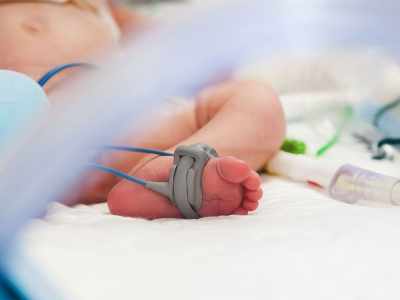No wires, more cuddles: Lightweight sensors to monitor babies in intensive care

A team from Northwestern University has successfully developed wireless sensors to monitor infants in intensive care. These new wireless sensors weigh little more than a raindrop, and can replace existing cumbersome and heavy wire-based monitoring systems. This new technology improves the experience of in-patient families, and can even provide more advanced measurements of a child’s vital signs.
Time for physical bonding
There would be few moments more difficult for new parents than seeing their infant in intensive care. Adding to this stress is the vast network of wires monitoring the baby’s vital signs, which often weigh more than the child itself.
Although essential for monitoring infant health, babies in NICU may require as many as 6 wires and electrodes to measure vital signs – including heartbeat, breathing, blood pressure and oxygen levels. This jumble of wires often restricts the child’s natural movement, and makes it challenging for parents to hold or physically bond with their child.
“We know that skin-to-skin contact is so important for newborns – especially those who are sick or premature,” Dr. Amy Paller, a pediatric dermatologist, told
media sources.
“It’s been shown to decrease the risk of pulmonary complications, liver issues and infections. Yet, when you have wires everywhere and the baby is tethered to a bed, it’s really hard to make skin-to-skin contact.”
Wireless is the way forward
Northwestern University believes that wireless is the way forward, and have developed patch sensors worn on the skin that weigh less than a raindrop! This advanced technology makes it far easier for parents to hold their baby, or to perform simple but vital tasks such as feeding and changing.
Sensors are placed on the baby’s chest and foot, enabling doctors to measure the core temperature of the baby. The difference between the child’s core temperature at its chest and foot is then used to measure other vital signs. The new wireless sensors also incorporate a transmitter located underneath the baby’s mattress, which sends data directly to the nurses’ station.
Unlike traditional wiring, the new sensors have also been cleverly designed to be worn during essential examinations such as X-rays, MRI’s and CT scans without disrupting the imaging.
In addition, where traditional wiring adhesives can cause considerable damage to the fragile skin of newborn babies, these new wireless sensors have a lightweight, paper-thin design made from bio-compatible soft elastic silicone.
Technology could be applied globally
“We wanted to eliminate the rat’s nest of wires and aggressive adhesives associated with existing hardware systems and replace them with something safer, more patient-centric and more compatible with parent-child interaction,” John A. Rogers, a bio-electronics developer, told
media sources.
“We were able to reproduce all of the functionality that current wire-based sensors provide with clinical-grade precision. Our wireless, battery-free, skin-like devices give up nothing in terms of range of measurement, accuracy and precision – and they even provide advanced measurements that are clinically important but not commonly collected.”
Initial trials involved just 20 infants, however the success of these studies have meant an additional 70 babies (and their families) have benefited from this wireless technology. Researchers estimate that wireless sensors will appear in American hospitals within the next 2 – 3 three years, with an international roll-out also anticipated.

